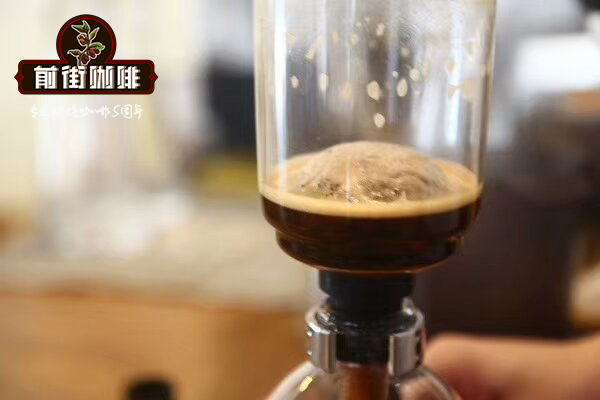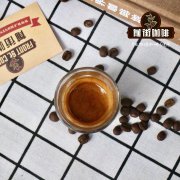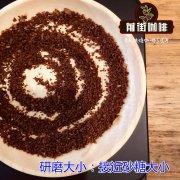Is it better to grind coffee beans in siphon pot? Comparison of different flavors of coffee beans in siphon pot

Professional coffee knowledge exchange more coffee bean information please follow the coffee workshop (Wechat official account cafe_style)
Because the siphon pot coffee produced in the store was relatively small before, and there was not much research on brewing parameters and so on. In fact, it is nothing more than water temperature, degree of grinding, ratio of powder to water, and brewing time. Recently, someone suddenly asked, in the face of coffee beans that have not been boiled in a siphon pot, how to determine the degree of grinding? The simplest idea is, of course, to adjust the grinding of hand-brewed coffee as a reference value, but here comes the question again: should the siphon pot of coffee powder be thicker or finer than the hand-brewed coffee?
Source of contradiction:
The main results are as follows: 1. Because the hand brew coffee is a cooling extraction, and the siphon pot coffee is a rising temperature extraction, even if the initial temperature is the same, the average extraction water temperature of the siphon pot coffee will still be higher than that of the hand brew coffee by 2 ml ~ 3 degrees. So: to prevent over-extraction, siphon pot coffee should be ground thicker?
2. Because the extraction time of hand-brewed coffee is usually about 2 minutes, while that of siphon pot coffee is about one minute. And hand-brewed coffee is filtered extraction, siphon pot coffee is immersion extraction, in the extraction rate, hand-brewed coffee should be higher than siphon pot. So: to prevent over-extraction, siphon pot coffee should be ground more finely?
Finally, I decided to do an experiment to see what kind of grinding degree is more suitable for siphon pot coffee.
Siphon pot brewing-sun Sidama Sakuran
Grinding degree
Powder-water ratio
Water temperature
Cooking time
Experimental group ①
BG:3M
1:12
90 °C
60 seconds.
Experimental group ②
BG:5M
1:12
90 °C
60 seconds.
As our daily hand-made-Sakui recommended grinding degree is in BG:4M, so choose these two parameters to compare, just slightly thicker than hand-brewed coffee grinding 1 scale and slightly thinner 1 scale.
As for other parameters, try to use the same technique to ensure the objectivity of the comparison. For example, the ratio of powder to water, water temperature, as well as cooking time, mixing methods.
Specific cooking records:
20.8 grams of beans, 240 grams of water, 90 °C water temperature, then add powder. Add powder and stir 5 times, steam for 39 seconds and stir 5 times, turn off heat for 60 seconds and stir 2 times, then quickly cool and reduce pressure and accelerate siphon reflux.
Flavor description comparison:
Experimental group ①: nut, lemon fruit acid, citrus, peach honey, dark chocolate, bitter taste is obvious, grease is obvious, taste slightly bitter; after a little cool, the sour taste becomes obvious, the aroma is more obvious, the whole is more rich but still slightly bitter.
Experimental group ②: fruit acid, grapefruit, citrus, aroma is obvious, fat feeling is lighter, taste is light, bitterness is less, taste is sour and astringent, overall light, but the flavor is more balanced.
Voting result: the experimental group ② is slightly better.
Cooking analysis: excluding the influence of the collocation of techniques and parameters, indeed, in the case of fine grinding, the flavor of the siphon pot will be more complete, the mellow thickness will be better, and all kinds of flavors will be put together in front, middle and back, but there will be a kind of repressed feeling. and the bitterness will be easier to come out, after all, after three times of stirring and not low water temperature cooking In the case of rough grinding, the flavor will be somewhat defective, the overall taste is relatively thin and light, and the taste is somewhat similar to that of hand-brewed coffee, but the overall hierarchical sense is shown, and the taste is easier to accept. The key is that the fault tolerance rate is high. Will not easily "dog belt"! It is especially suitable for those who are not familiar with the operation of the siphon pot or do not understand the characteristics of beans.
Comparison conclusion: although it is only a comparison between the two groups of siphon pot coffee, through a simple comparison, we can still draw a conclusion: when the whole brewing idea is not clear and there is no relevant brewing experience and data for reference, a thicker grinding will be more suitable for everyone-- because of the high fault tolerance rate, even if you are in a hurry, at least you will not brew a cup of thick, bitter, scorched siphon pot coffee because the brewing time is too long. Isn't it the "wall" that beginners are most likely to hit when playing with a siphon pot?
END
Important Notice :
前街咖啡 FrontStreet Coffee has moved to new addredd:
FrontStreet Coffee Address: 315,Donghua East Road,GuangZhou
Tel:020 38364473
- Prev

Is it a waste of fine coffee beans to make espresso? Which kind of beans is better for espresso beans?
Professional coffee knowledge exchange more coffee bean information please follow the coffee workshop (Wechat official account cafe_style) Coffee Xiaobai ask a question. There is an understanding that it is not correct to use espresso as espresso compared to hand-brewed or cold-extracted coffee, so it is relatively common or blended coffee beans are more suitable for making strong coffee.
- Next

Siphon pot coffee bean grinding degree Cui Qi time parameter suggestion _ siphon pot how fine coffee beans are ground
Professional coffee knowledge exchange more coffee bean information Please pay attention to coffee workshop (Wechat official account cafe_style) siphon pot coffee originated in Europe and the United States, but it is popular in Asia, after all, elegant siphon utensils and magical production process charm enough to fascinate many people. Siphon coffee has elegant utensils and operation, as well as the adjustment of the chemical experiment, watching the hot water slowly from the bottom pot.
Related
- What is the Philharmonic pressure? How to use Philharmonic pressure to make delicious coffee
- Why does a hand grinder have more fine powder than an electric grinder?
- In addition to the hot mom, what is the difference between the versions of EK43 | ditting and Mahdi ek43?
- What kind of equipment do you need to make coffee by hand? Introduction to novice starter cooking equipment tools
- Espresso needs to be ground how thick and thin scale entry Italian Coffee Machine Bean Grinder investigation and Grinding course
- How much does it cost to open a small private cafe? How much does it cost to learn coffee? How to operate it?
- The difference between the flavor characteristics of hand-brewed coffee and coffee maker is hand-brewed coffee really better than coffee maker? Can I use a coffee machine to make coffee beans by hand?
- The difference between 01 and 02 of hario v60 filter cup what is the difference between 01 and 02 filter cup opening and cooking flavor
- What's the difference between the smart cup and the French kettle? Which is better, the French kettle or the Smart Cup?
- What's the difference between a smart cup and a V60 filter cup? The difference between the taste of smart cup and hand-brewed coffee

